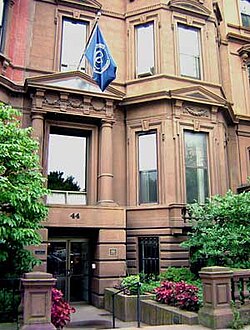 The College Club of Boston | |
| Abbreviation | CCoB |
|---|---|
| Formation | December 1890 |
| Type | NGO |
| Legal status | Foundation |
| Purpose | Educational |
| Location | |
| Coordinates | 42°21′10″N71°04′24″W / 42.3527259°N 71.073338°W |
Region served | Boston, Boston Public Schools |
| Membership | Private |
Official language | English |
| Website | thecollegeclubofboston |
The College Club of Boston is a private membership organization founded in 1890 as the first women's college club in the United States. Located in the historic Back Bay of Boston, Massachusetts, at 44 Commonwealth Avenue, the College Club was established by nineteen college educated women whose mission was to form a social club where they and other like-minded women could meet and share companionship.